FIAT STRADA 2011 Owner handbook (in English)
Manufacturer: FIAT, Model Year: 2011, Model line: STRADA, Model: FIAT STRADA 2011Pages: 195, PDF Size: 3.68 MB
Page 161 of 195
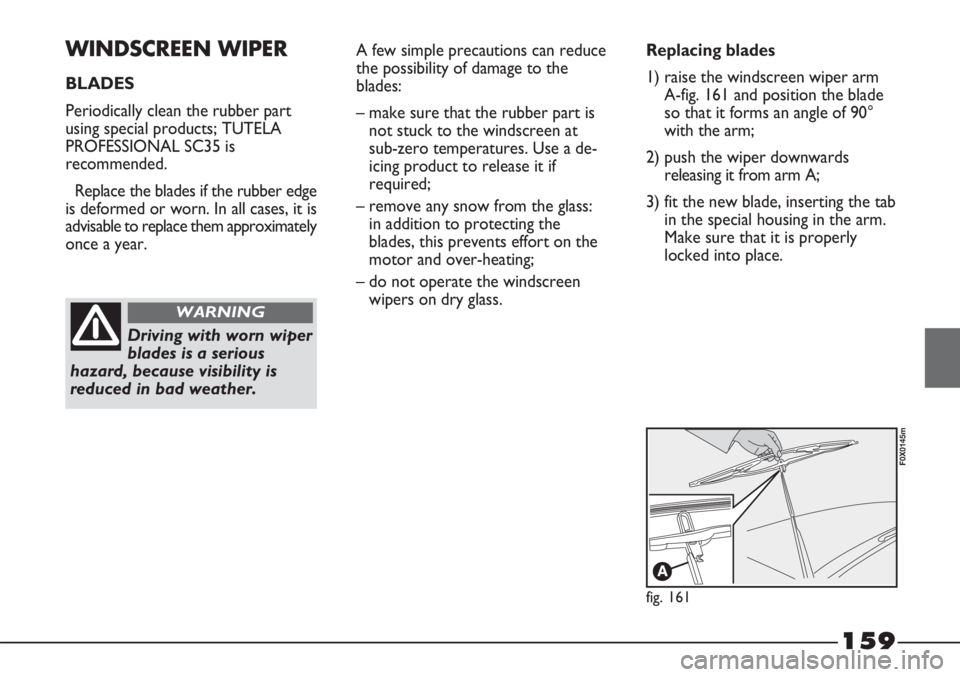
159
WINDSCREEN WIPER
BLADES
Periodically clean the rubber part
using special products; TUTELA
PROFESSIONAL SC35 is
recommended.
Replace the blades if the rubber edge
is deformed or worn. In all cases, it is
advisable to replace them approximately
once a year.
Driving with worn wiper
blades is a serious
hazard, because visibility is
reduced in bad weather.
WARNING
A few simple precautions can reduce
the possibility of damage to the
blades:
– make sure that the rubber part is
not stuck to the windscreen at
sub-zero temperatures. Use a de-
icing product to release it if
required;
– remove any snow from the glass:
in addition to protecting the
blades, this prevents effort on the
motor and over-heating;
– do not operate the windscreen
wipers on dry glass.Replacing blades
1) raise the windscreen wiper arm
A-fig. 161 and position the blade
so that it forms an angle of 90°
with the arm;
2) push the wiper downwards
releasing it from arm A;
3) fit the new blade, inserting the tab
in the special housing in the arm.
Make sure that it is properly
locked into place.
fig. 161
F0X0145m
Page 162 of 195
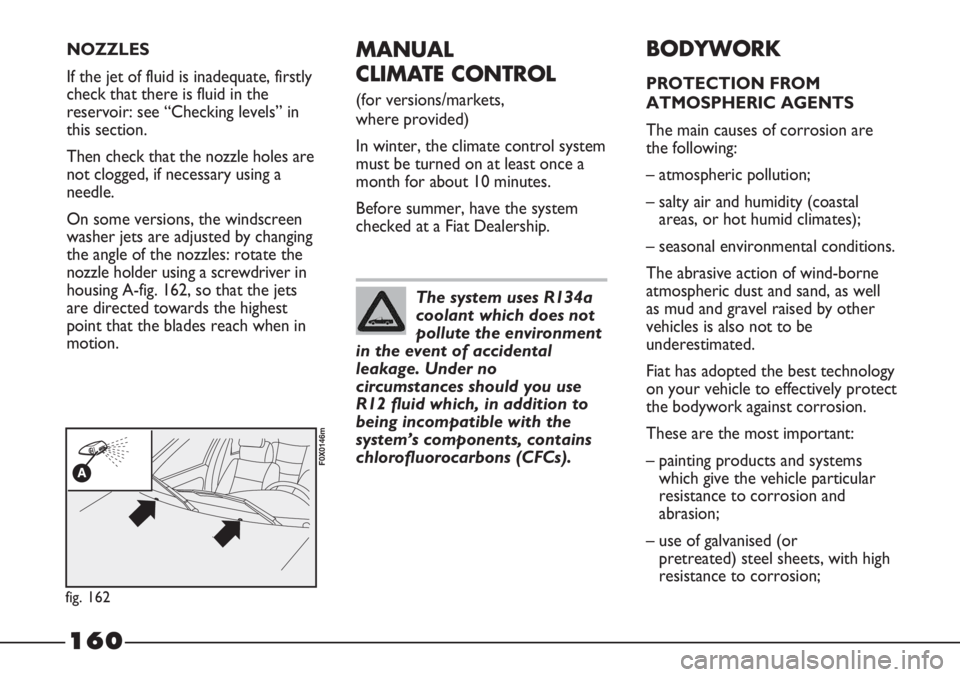
160
MANUAL
CLIMATE CONTROL
(for versions/markets,
where provided)
In winter, the climate control system
must be turned on at least once a
month for about 10 minutes.
Before summer, have the system
checked at a Fiat Dealership.
BODYWORK
PROTECTION FROM
ATMOSPHERIC AGENTS
The main causes of corrosion are
the following:
– atmospheric pollution;
– salty air and humidity (coastal
areas, or hot humid climates);
– seasonal environmental conditions.
The abrasive action of wind-borne
atmospheric dust and sand, as well
as mud and gravel raised by other
vehicles is also not to be
underestimated.
Fiat has adopted the best technology
on your vehicle to effectively protect
the bodywork against corrosion.
These are the most important:
– painting products and systems
which give the vehicle particular
resistance to corrosion and
abrasion;
– use of galvanised (or
pretreated) steel sheets, with high
resistance to corrosion;
The system uses R134a
coolant which does not
pollute the environment
in the event of accidental
leakage. Under no
circumstances should you use
R12 fluid which, in addition to
being incompatible with the
system’s components, contains
chlorofluorocarbons (CFCs).
NOZZLES
If the jet of fluid is inadequate, firstly
check that there is fluid in the
reservoir: see “Checking levels” in
this section.
Then check that the nozzle holes are
not clogged, if necessary using a
needle.
On some versions, the windscreen
washer jets are adjusted by changing
the angle of the nozzles: rotate the
nozzle holder using a screwdriver in
housing A-fig. 162, so that the jets
are directed towards the highest
point that the blades reach when in
motion.
fig. 162
F0X0146m
Page 163 of 195
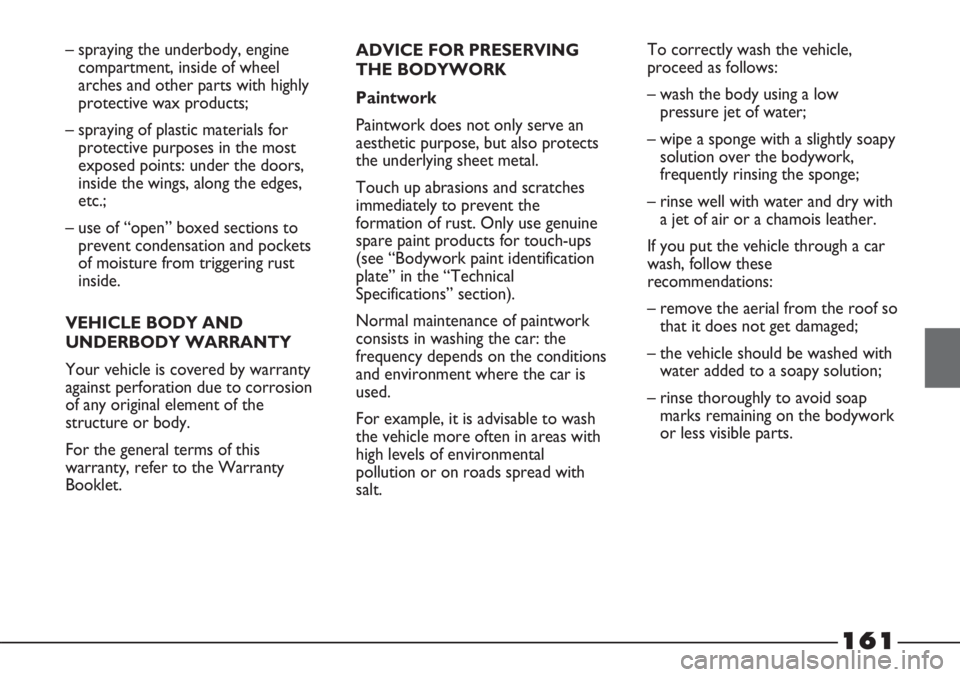
161
– spraying the underbody, engine
compartment, inside of wheel
arches and other parts with highly
protective wax products;
– spraying of plastic materials for
protective purposes in the most
exposed points: under the doors,
inside the wings, along the edges,
etc.;
– use of “open” boxed sections to
prevent condensation and pockets
of moisture from triggering rust
inside.
VEHICLE BODY AND
UNDERBODY WARRANTY
Your vehicle is covered by warranty
against perforation due to corrosion
of any original element of the
structure or body.
For the general terms of this
warranty, refer to the Warranty
Booklet.ADVICE FOR PRESERVING
THE BODYWORK
Paintwork
Paintwork does not only serve an
aesthetic purpose, but also protects
the underlying sheet metal.
Touch up abrasions and scratches
immediately to prevent the
formation of rust. Only use genuine
spare paint products for touch-ups
(see “Bodywork paint identification
plate” in the “Technical
Specifications” section).
Normal maintenance of paintwork
consists in washing the car: the
frequency depends on the conditions
and environment where the car is
used.
For example, it is advisable to wash
the vehicle more often in areas with
high levels of environmental
pollution or on roads spread with
salt.To correctly wash the vehicle,
proceed as follows:
– wash the body using a low
pressure jet of water;
– wipe a sponge with a slightly soapy
solution over the bodywork,
frequently rinsing the sponge;
– rinse well with water and dry with
a jet of air or a chamois leather.
If you put the vehicle through a car
wash, follow these
recommendations:
– remove the aerial from the roof so
that it does not get damaged;
– the vehicle should be washed with
water added to a soapy solution;
– rinse thoroughly to avoid soap
marks remaining on the bodywork
or less visible parts.
Page 164 of 195

162
Exterior plastic parts should be
cleaned in the same way as the rest
of the vehicle. Where possible, do
not park the vehicle under trees; the
resinous substances released by
many species give the paint a dull
appearance and increase the
possibility of corrosion.
IMPORTANT Bird droppings must
be washed off immediately and
thoroughly, as the acid they contain
is particularly aggressive.Windows
To clean windows, use specific
cleaning products.
Use clean cloths to avoid scratching
the glass or damaging the
transparency.
Engine compartment
At the end of each winter,
thoroughly wash the engine
compartment, taking care to avoid
spraying the water jet directly onto
the electronic control units or the
fuse box on the left side of the
engine compartment (driving
direction).
Have this operation performed at a
specialised workshop.
IMPORTANT Washing should take
place with the engine cold and the
ignition key removed.
After the washing operation, make
sure that the various protections
(e.g. rubber caps and guards) have
not been removed or damaged.
Detergents cause water
pollution. The vehicle
should be washed in
areas equipped for collecting
and purifying the liquid used in
the washing process.
Some car washes with
old-style blades and/or
in a poor state of repair
can damage the paintwork,
facilitating the formation of
lines that give the paint a
dull/misty appearance,
especially on dark colours.
If this happens, lightly polish the
paintwork with appropriate
products.
Dry the less visible parts, such as the
door frames, bonnet and the
headlight frames with special care, as
in these areas water may stagnate
more easily.
It is a good idea to leave the vehicle
outdoors for a while after washing it
to give the water time to evaporate.
Do not wash the vehicle after it has
been left in the sun or with the
bonnet hot: this may alter the shine
of the paintwork.
Page 165 of 195
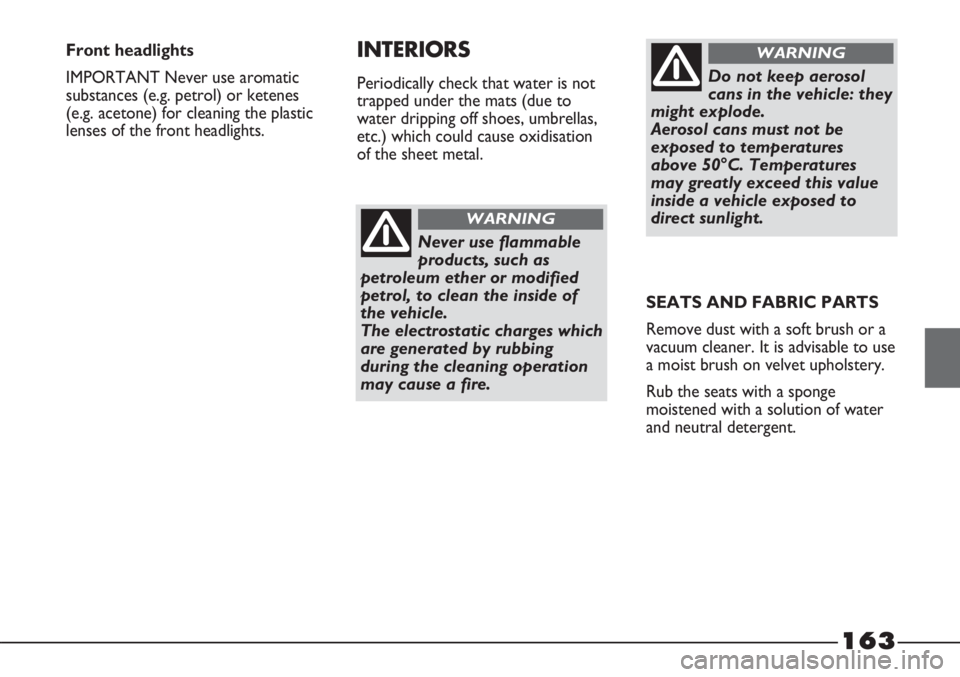
163
Never use flammable
products, such as
petroleum ether or modified
petrol, to clean the inside of
the vehicle.
The electrostatic charges which
are generated by rubbing
during the cleaning operation
may cause a fire.
WARNING
Do not keep aerosol
cans in the vehicle: they
might explode.
Aerosol cans must not be
exposed to temperatures
above 50°C. Temperatures
may greatly exceed this value
inside a vehicle exposed to
direct sunlight.
WARNINGFront headlights
IMPORTANT Never use aromatic
substances (e.g. petrol) or ketenes
(e.g. acetone) for cleaning the plastic
lenses of the front headlights.INTERIORS
Periodically check that water is not
trapped under the mats (due to
water dripping off shoes, umbrellas,
etc.) which could cause oxidisation
of the sheet metal.
SEATS AND FABRIC PARTS
Remove dust with a soft brush or a
vacuum cleaner. It is advisable to use
a moist brush on velvet upholstery.
Rub the seats with a sponge
moistened with a solution of water
and neutral detergent.
Page 166 of 195
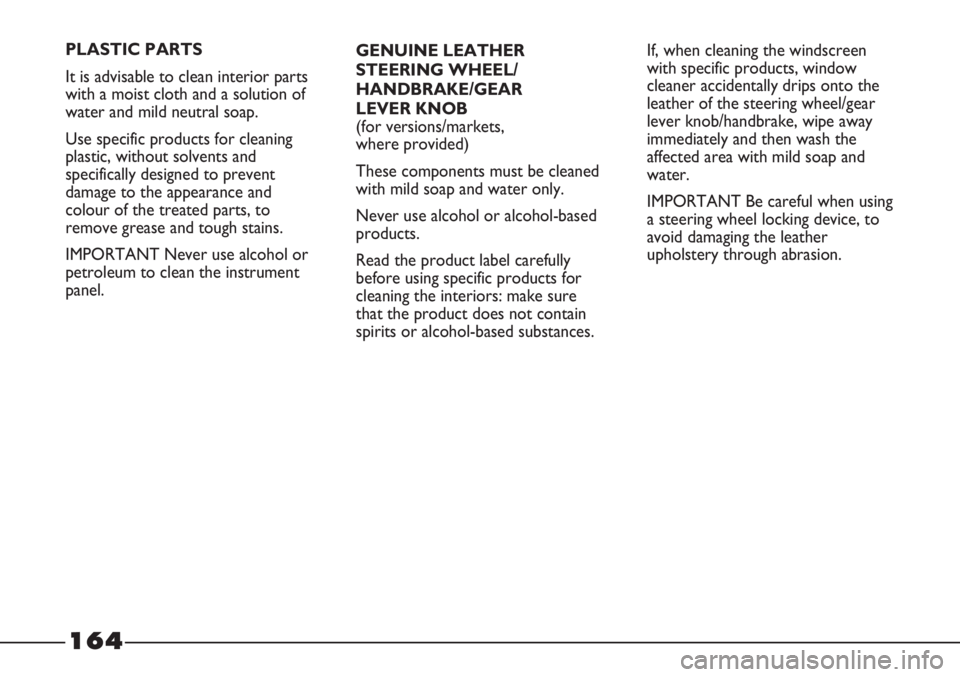
164
GENUINE LEATHER
STEERING WHEEL/
HANDBRAKE/GEAR
LEVER KNOB
(for versions/markets,
where provided)
These components must be cleaned
with mild soap and water only.
Never use alcohol or alcohol-based
products.
Read the product label carefully
before using specific products for
cleaning the interiors: make sure
that the product does not contain
spirits or alcohol-based substances.If, when cleaning the windscreen
with specific products, window
cleaner accidentally drips onto the
leather of the steering wheel/gear
lever knob/handbrake, wipe away
immediately and then wash the
affected area with mild soap and
water.
IMPORTANT Be careful when using
a steering wheel locking device, to
avoid damaging the leather
upholstery through abrasion. PLASTIC PARTS
It is advisable to clean interior parts
with a moist cloth and a solution of
water and mild neutral soap.
Use specific products for cleaning
plastic, without solvents and
specifically designed to prevent
damage to the appearance and
colour of the treated parts, to
remove grease and tough stains.
IMPORTANT Never use alcohol or
petroleum to clean the instrument
panel.
Page 167 of 195
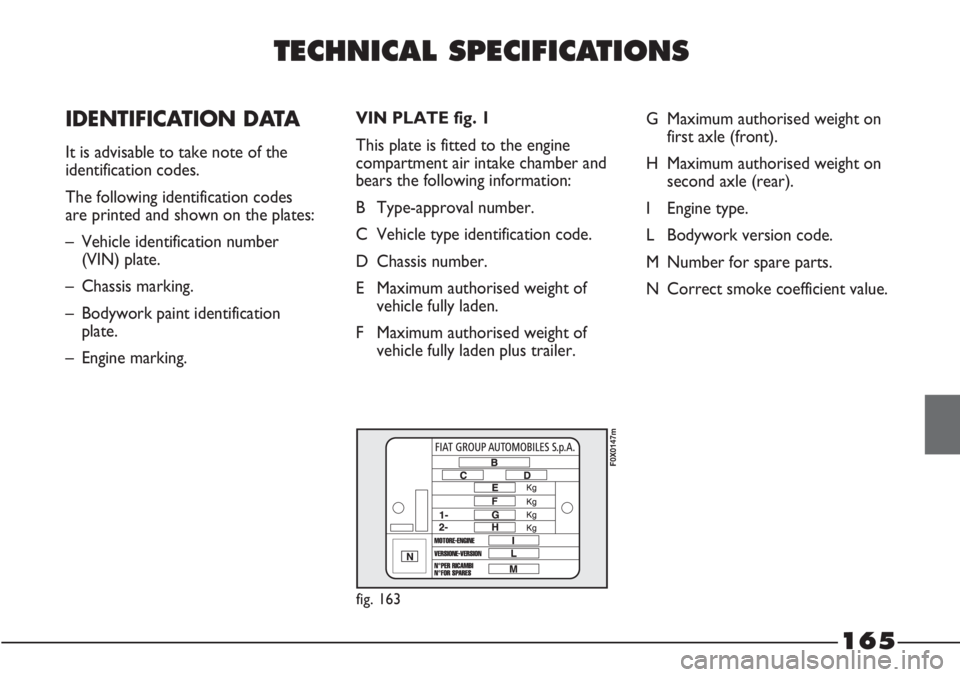
TECHNICAL SPECIFICATIONS
IDENTIFICATION DATA
It is advisable to take note of the
identification codes.
The following identification codes
are printed and shown on the plates:
– Vehicle identification number
(VIN) plate.
– Chassis marking.
– Bodywork paint identification
plate.
– Engine marking.VIN PLATE fig. 1
This plate is fitted to the engine
compartment air intake chamber and
bears the following information:
B Type-approval number.
C Vehicle type identification code.
D Chassis number.
E Maximum authorised weight of
vehicle fully laden.
F Maximum authorised weight of
vehicle fully laden plus trailer.
fig. 163
F0X0147m
G Maximum authorised weight on
first axle (front).
H Maximum authorised weight on
second axle (rear).
I Engine type.
L Bodywork version code.
M Number for spare parts.
N Correct smoke coefficient value.
165
Page 168 of 195

166
BODYWORK PAINT
IDENTIFICATION PLATE
fig. 164
This is applied to the inside of the
passenger side door and bears the
following information:
A Paint manufacturer.
B Colour name.
C Fiat colour code.
D Re-spray and touch-up colour
code.CHASSIS MARKING fig. 165
This is located on the passenger
compartment floor panel, near the
right front seat; open flap A
to access.
The marking includes:
– vehicle model;
– chassis number.
fig. 164
F0X0148m
fig. 165
F0X0149m
ENGINE MARKING
This is stamped on the cylinder
block and includes the model and
the manufacturing serial number.
Page 169 of 195
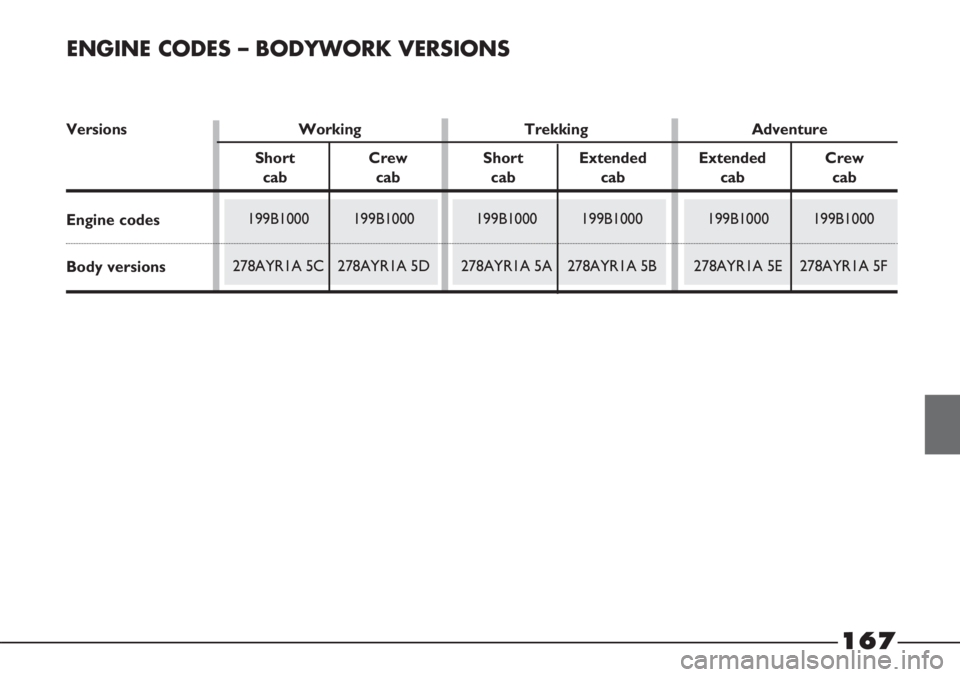
199B1000 199B1000
278AYR1A 5E 278AYR1A 5F199B1000 199B1000
278AYR1A 5A 278AYR1A 5B199B1000 199B1000
278AYR1A 5C 278AYR1A 5D
167
Versions Working Trekking Adventure
Short Crew Short Extended Extended Crew
cab cab cab cab cab cab
Engine codes
Body versions
ENGINE CODES – BODYWORK VERSIONS
Page 170 of 195

168
ENGINE
GENERAL INFORMATION
Type code
Cycle
Number and arrangement of cylinders
Number of valves per cylinder
Piston bore and stroke mm
Total displacement cm3
Compression ratio
Max. power (EEC) kW
HP
at a speed of rpm
Max. torque (EEC) Nm
kgm
at a speed of rpm
Idle speed rpm
Fuel
1.3 MultiJet 16V
199B1000
Diesel
4 in line
4
69,6 x 82
1248
16,8 : 1
70
95
4000
200
20,4
1500
825 ± 50
Diesel for motor vehicles
(EN590 specification)